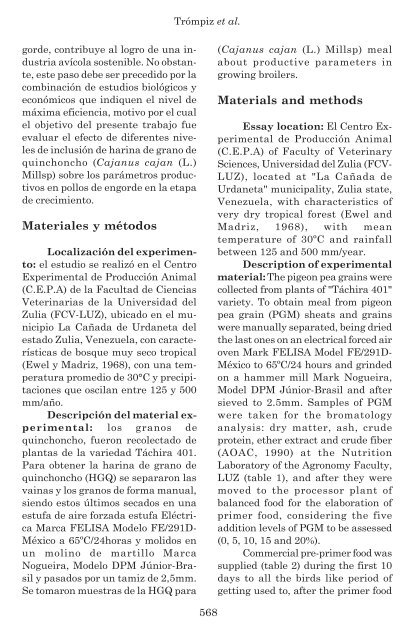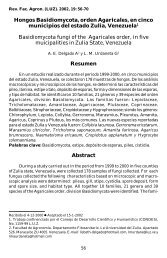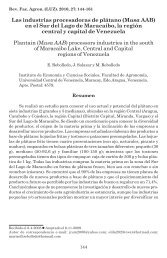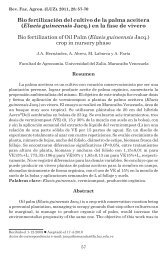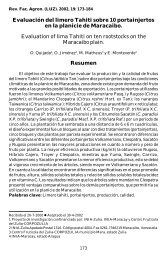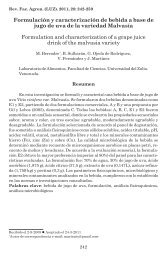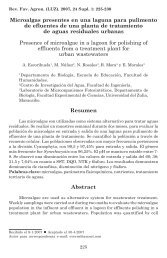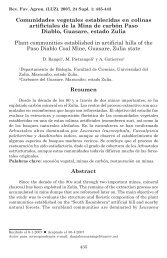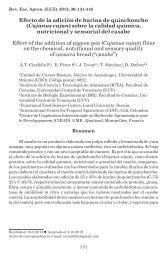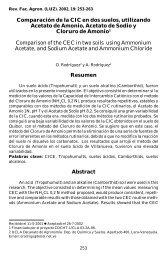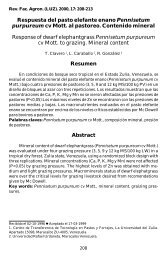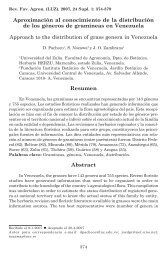Parámetros productivos en pollos de engorde alimentados con ...
Parámetros productivos en pollos de engorde alimentados con ...
Parámetros productivos en pollos de engorde alimentados con ...
You also want an ePaper? Increase the reach of your titles
YUMPU automatically turns print PDFs into web optimized ePapers that Google loves.
gor<strong>de</strong>, <strong>con</strong>tribuye al logro <strong>de</strong> una industria<br />
avícola sost<strong>en</strong>ible. No obstante,<br />
este paso <strong>de</strong>be ser precedido por la<br />
combinación <strong>de</strong> estudios biológicos y<br />
e<strong>con</strong>ómicos que indiqu<strong>en</strong> el nivel <strong>de</strong><br />
máxima efici<strong>en</strong>cia, motivo por el cual<br />
el objetivo <strong>de</strong>l pres<strong>en</strong>te trabajo fue<br />
evaluar el efecto <strong>de</strong> difer<strong>en</strong>tes niveles<br />
<strong>de</strong> inclusión <strong>de</strong> harina <strong>de</strong> grano <strong>de</strong><br />
quinchoncho (Cajanus cajan (L.)<br />
Millsp) sobre los parámetros <strong>productivos</strong><br />
<strong>en</strong> <strong>pollos</strong> <strong>de</strong> <strong>en</strong>gor<strong>de</strong> <strong>en</strong> la etapa<br />
<strong>de</strong> crecimi<strong>en</strong>to.<br />
Materiales y métodos<br />
Localización <strong>de</strong>l experim<strong>en</strong>to:<br />
el estudio se realizó <strong>en</strong> el C<strong>en</strong>tro<br />
Experim<strong>en</strong>tal <strong>de</strong> Producción Animal<br />
(C.E.P.A) <strong>de</strong> la Facultad <strong>de</strong> Ci<strong>en</strong>cias<br />
Veterinarias <strong>de</strong> la Universidad <strong>de</strong>l<br />
Zulia (FCV-LUZ), ubicado <strong>en</strong> el municipio<br />
La Cañada <strong>de</strong> Urdaneta <strong>de</strong>l<br />
estado Zulia, V<strong>en</strong>ezuela, <strong>con</strong> características<br />
<strong>de</strong> bosque muy seco tropical<br />
(Ewel y Madriz, 1968), <strong>con</strong> una temperatura<br />
promedio <strong>de</strong> 30°C y precipitaciones<br />
que oscilan <strong>en</strong>tre 125 y 500<br />
mm/año.<br />
Descripción <strong>de</strong>l material experim<strong>en</strong>tal:<br />
los granos <strong>de</strong><br />
quinchoncho, fueron recolectado <strong>de</strong><br />
plantas <strong>de</strong> la variedad Táchira 401.<br />
Para obt<strong>en</strong>er la harina <strong>de</strong> grano <strong>de</strong><br />
quinchoncho (HGQ) se separaron las<br />
vainas y los granos <strong>de</strong> forma manual,<br />
si<strong>en</strong>do estos últimos secados <strong>en</strong> una<br />
estufa <strong>de</strong> aire forzada estufa Eléctrica<br />
Marca FELISA Mo<strong>de</strong>lo FE/291D-<br />
México a 65ºC/24horas y molidos <strong>en</strong><br />
un molino <strong>de</strong> martillo Marca<br />
Nogueira, Mo<strong>de</strong>lo DPM Júnior-Brasil<br />
y pasados por un tamiz <strong>de</strong> 2,5mm.<br />
Se tomaron muestras <strong>de</strong> la HGQ para<br />
Trómpiz et al.<br />
568<br />
(Cajanus cajan (L.) Millsp) meal<br />
about productive parameters in<br />
growing broilers.<br />
Materials and methods<br />
Essay location: El C<strong>en</strong>tro Experim<strong>en</strong>tal<br />
<strong>de</strong> Producción Animal<br />
(C.E.P.A) of Faculty of Veterinary<br />
Sci<strong>en</strong>ces, Universidad <strong>de</strong>l Zulia (FCV-<br />
LUZ), located at "La Cañada <strong>de</strong><br />
Urdaneta" municipality, Zulia state,<br />
V<strong>en</strong>ezuela, with characteristics of<br />
very dry tropical forest (Ewel and<br />
Madriz, 1968), with mean<br />
temperature of 30ºC and rainfall<br />
betwe<strong>en</strong> 125 and 500 mm/year.<br />
Description of experim<strong>en</strong>tal<br />
material: The pigeon pea grains were<br />
collected from plants of "Táchira 401"<br />
variety. To obtain meal from pigeon<br />
pea grain (PGM) sheats and grains<br />
were manually separated, being dried<br />
the last ones on an electrical forced air<br />
ov<strong>en</strong> Mark FELISA Mo<strong>de</strong>l FE/291D-<br />
México to 65ºC/24 hours and grin<strong>de</strong>d<br />
on a hammer mill Mark Nogueira,<br />
Mo<strong>de</strong>l DPM Júnior-Brasil and after<br />
sieved to 2.5mm. Samples of PGM<br />
were tak<strong>en</strong> for the bromatology<br />
analysis: dry matter, ash, cru<strong>de</strong><br />
protein, ether extract and cru<strong>de</strong> fiber<br />
(AOAC, 1990) at the Nutrition<br />
Laboratory of the Agronomy Faculty,<br />
LUZ (table 1), and after they were<br />
moved to the processor plant of<br />
balanced food for the elaboration of<br />
primer food, <strong>con</strong>si<strong>de</strong>ring the five<br />
addition levels of PGM to be assessed<br />
(0, 5, 10, 15 and 20%).<br />
Commercial pre-primer food was<br />
supplied (table 2) during the first 10<br />
days to all the birds like period of<br />
getting used to, after the primer food


